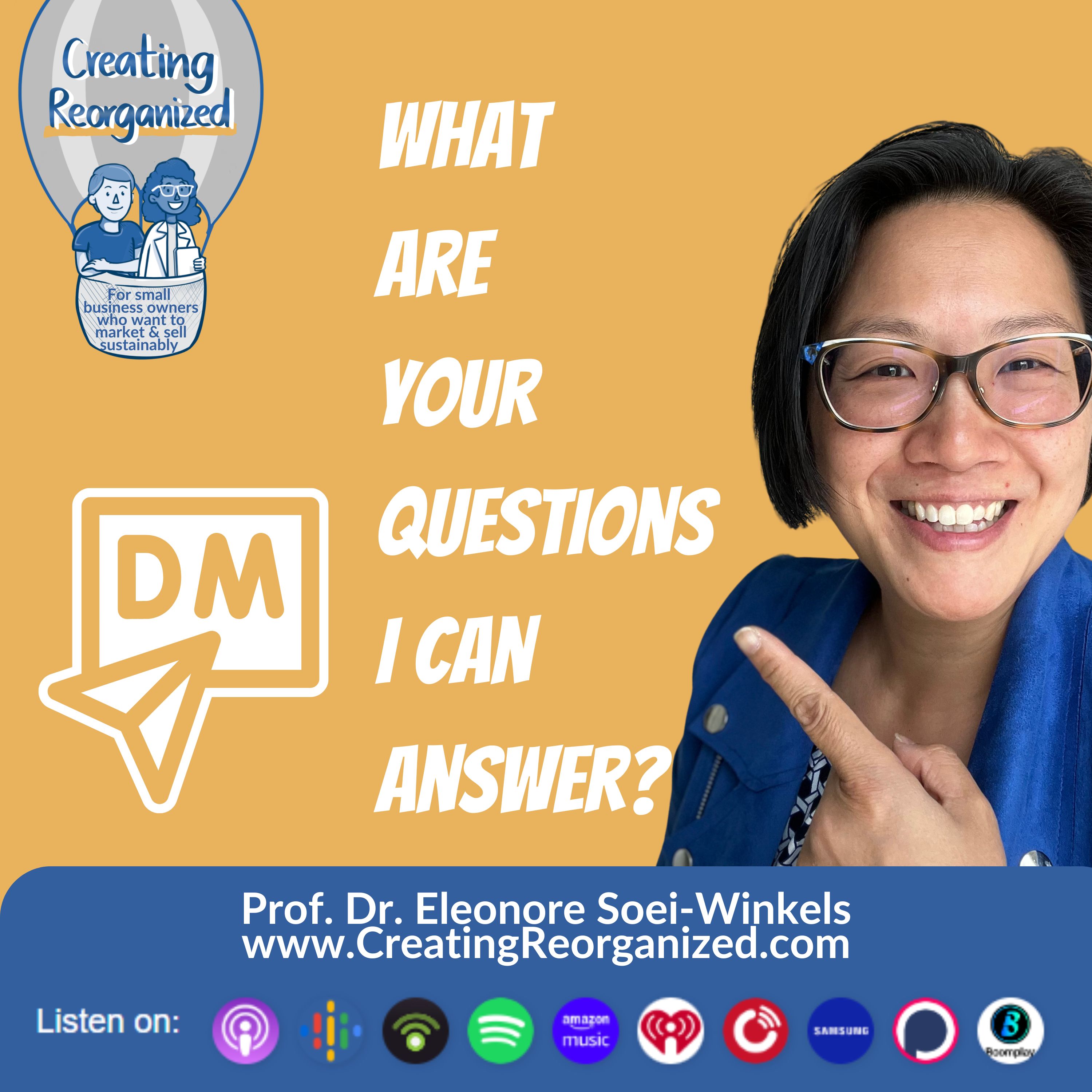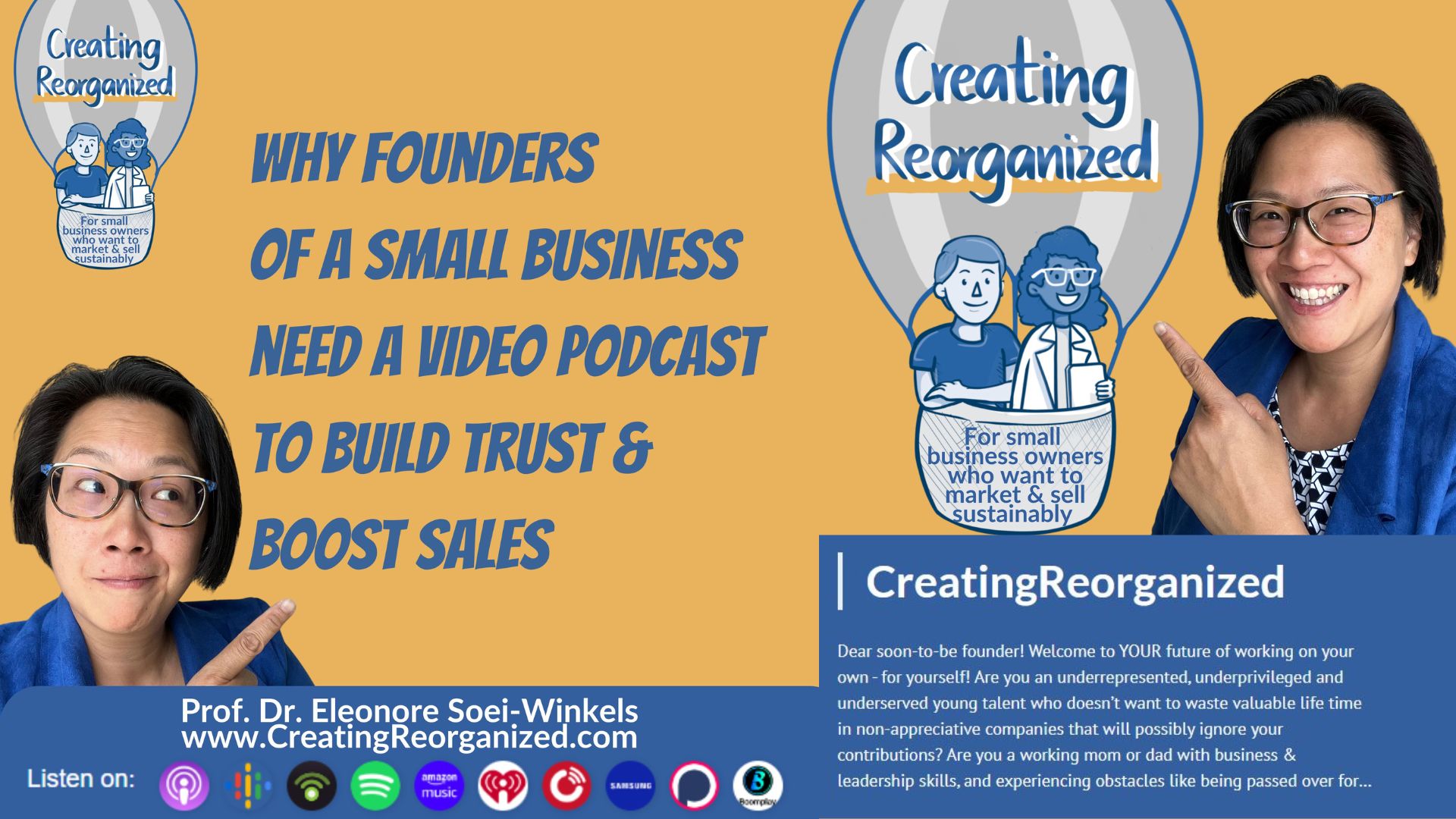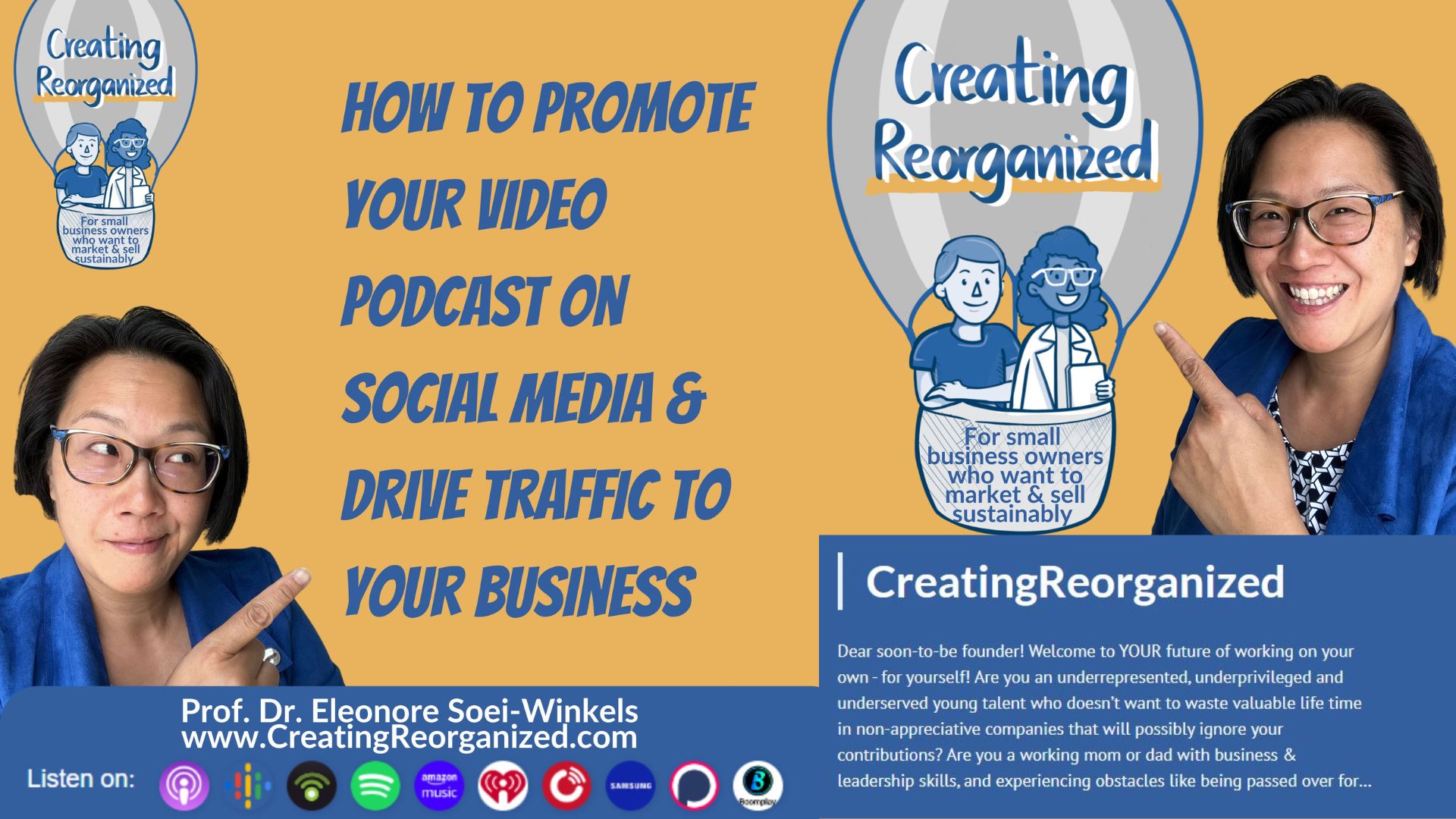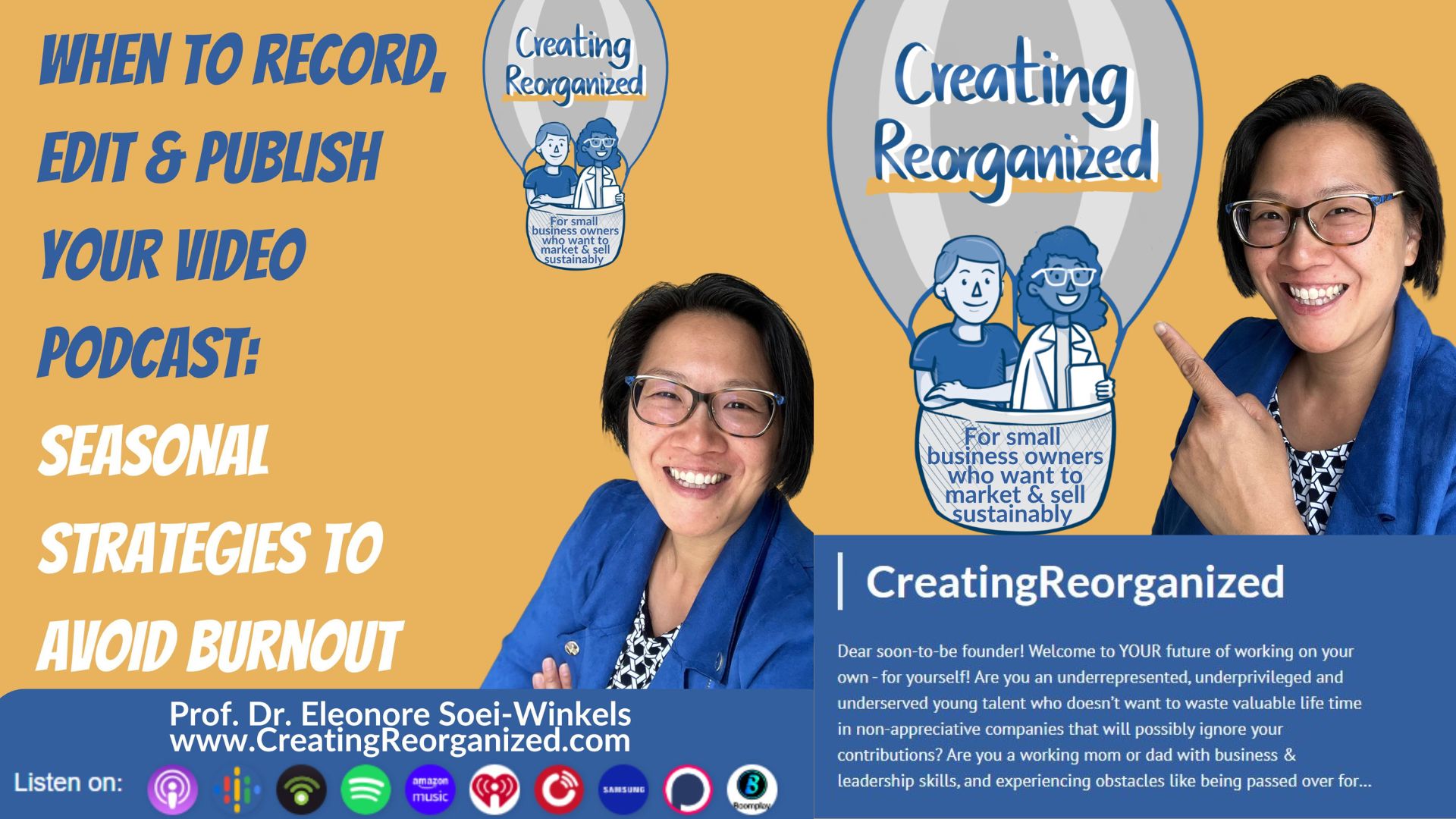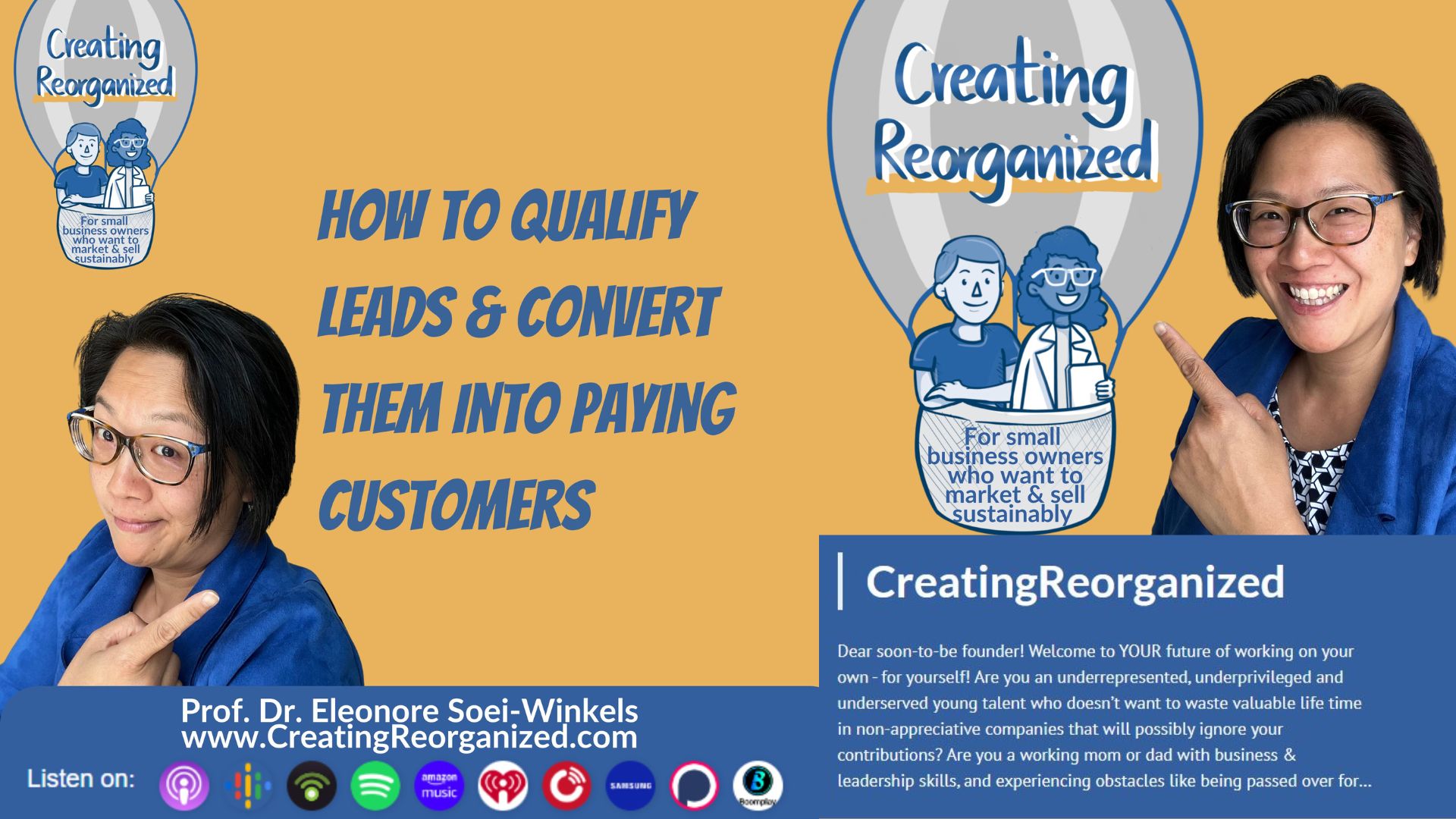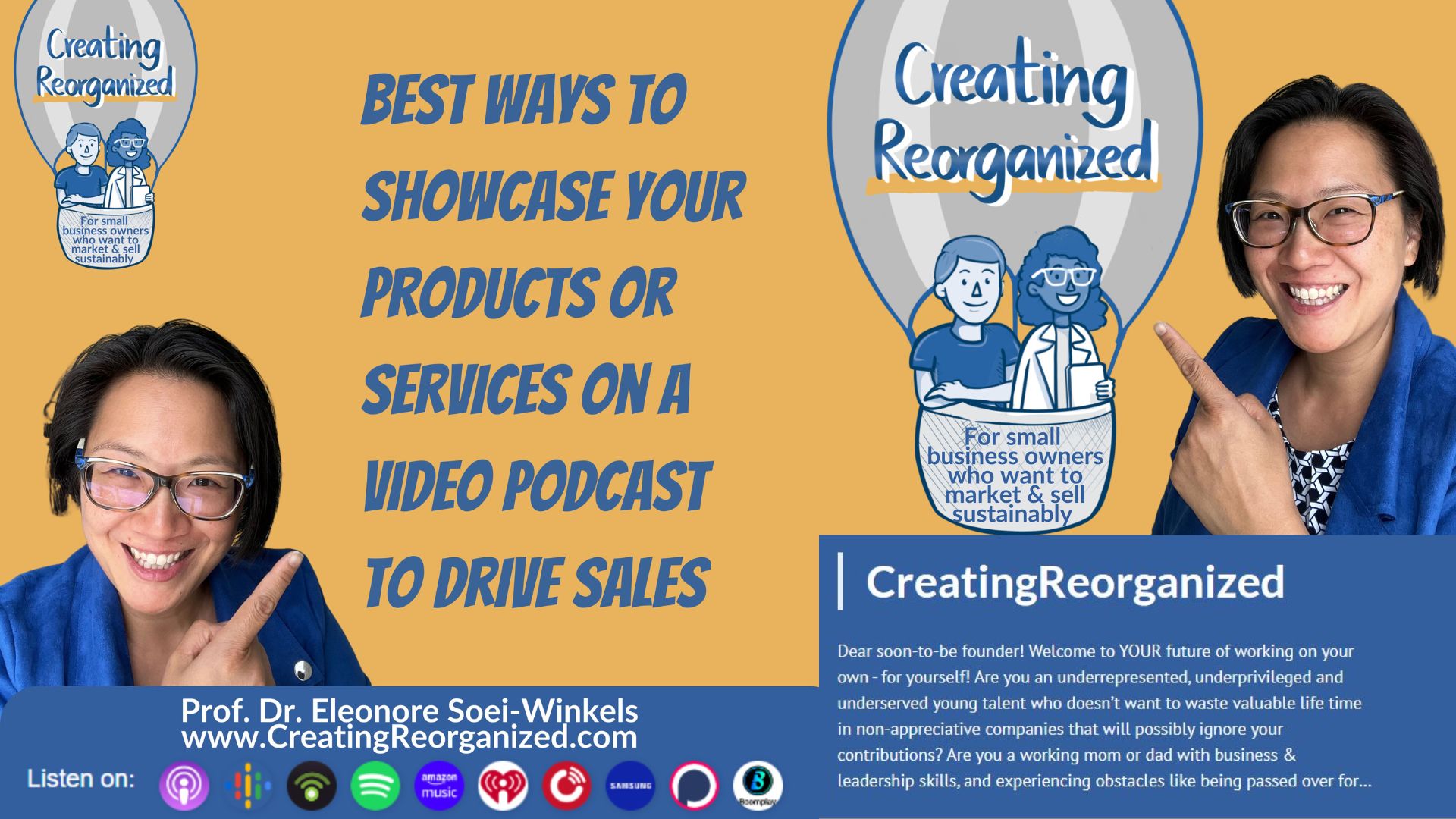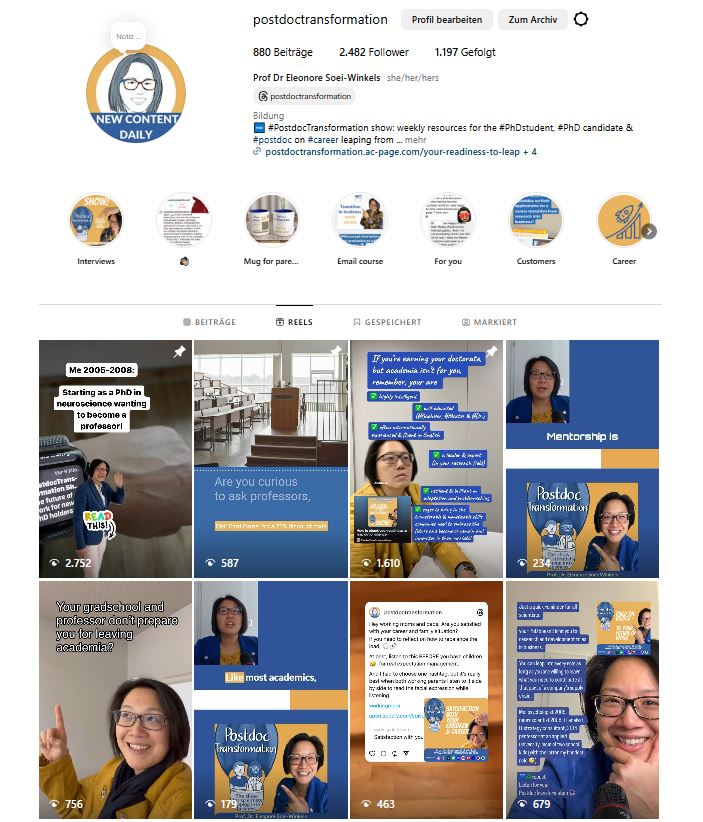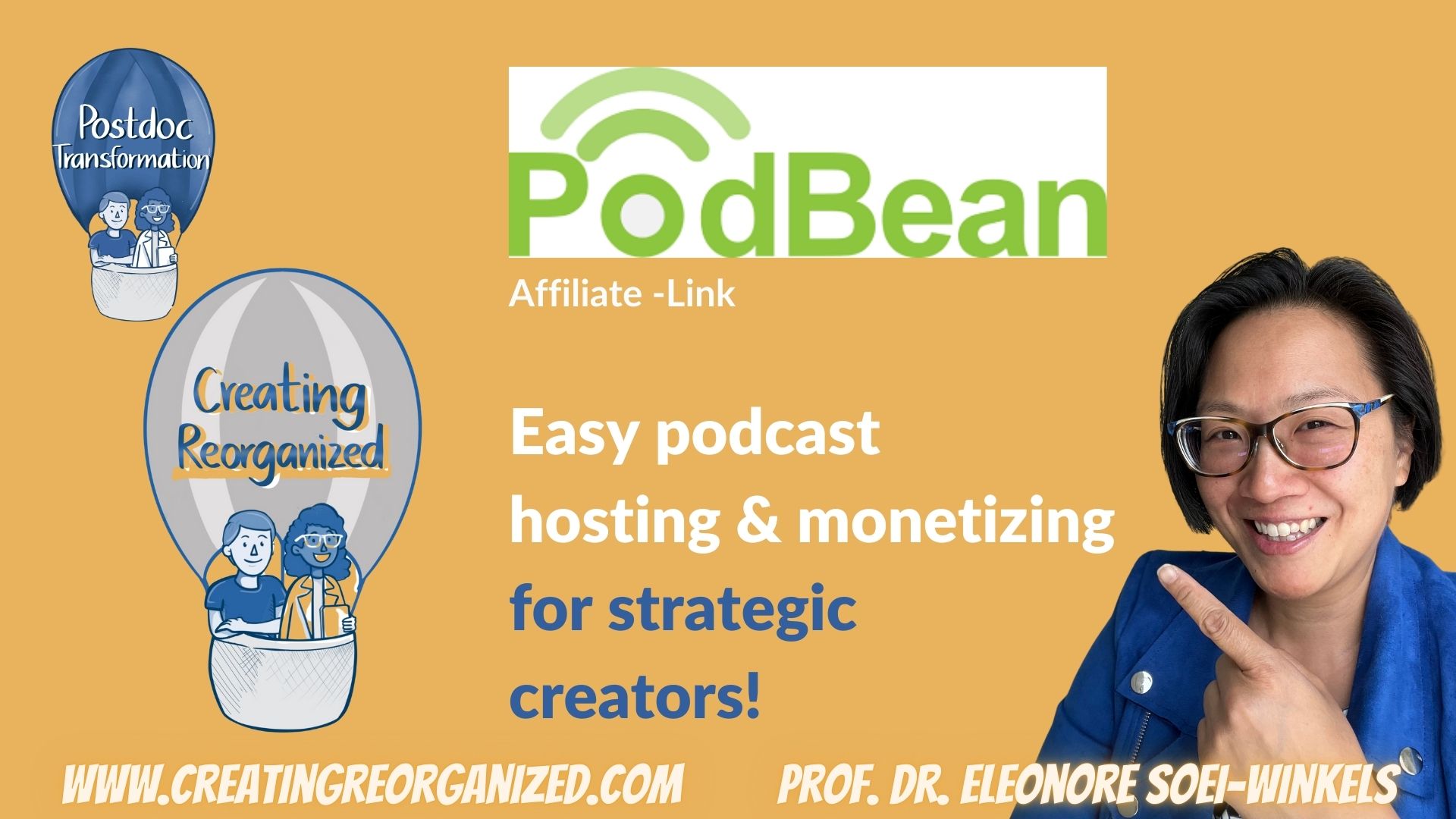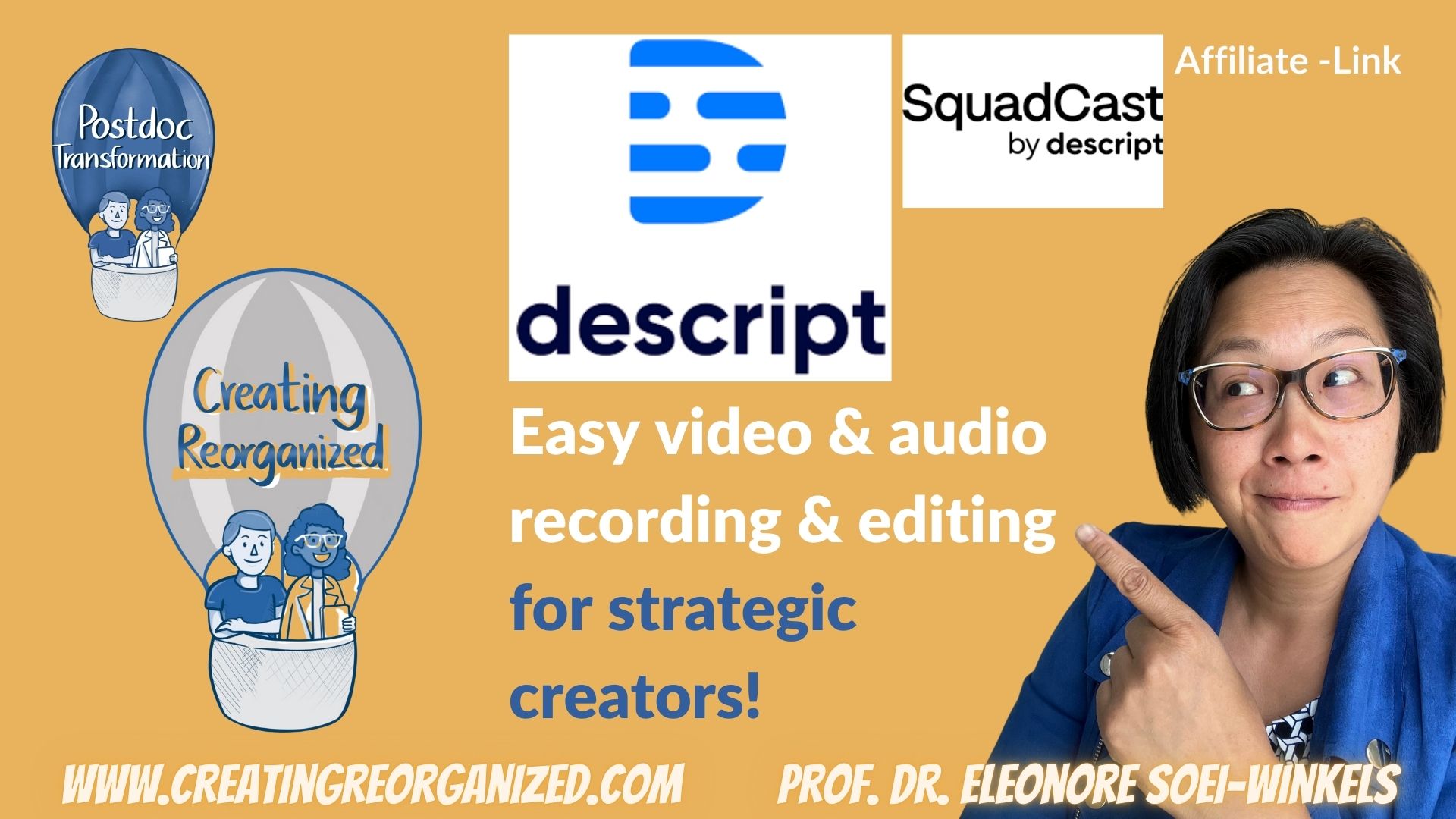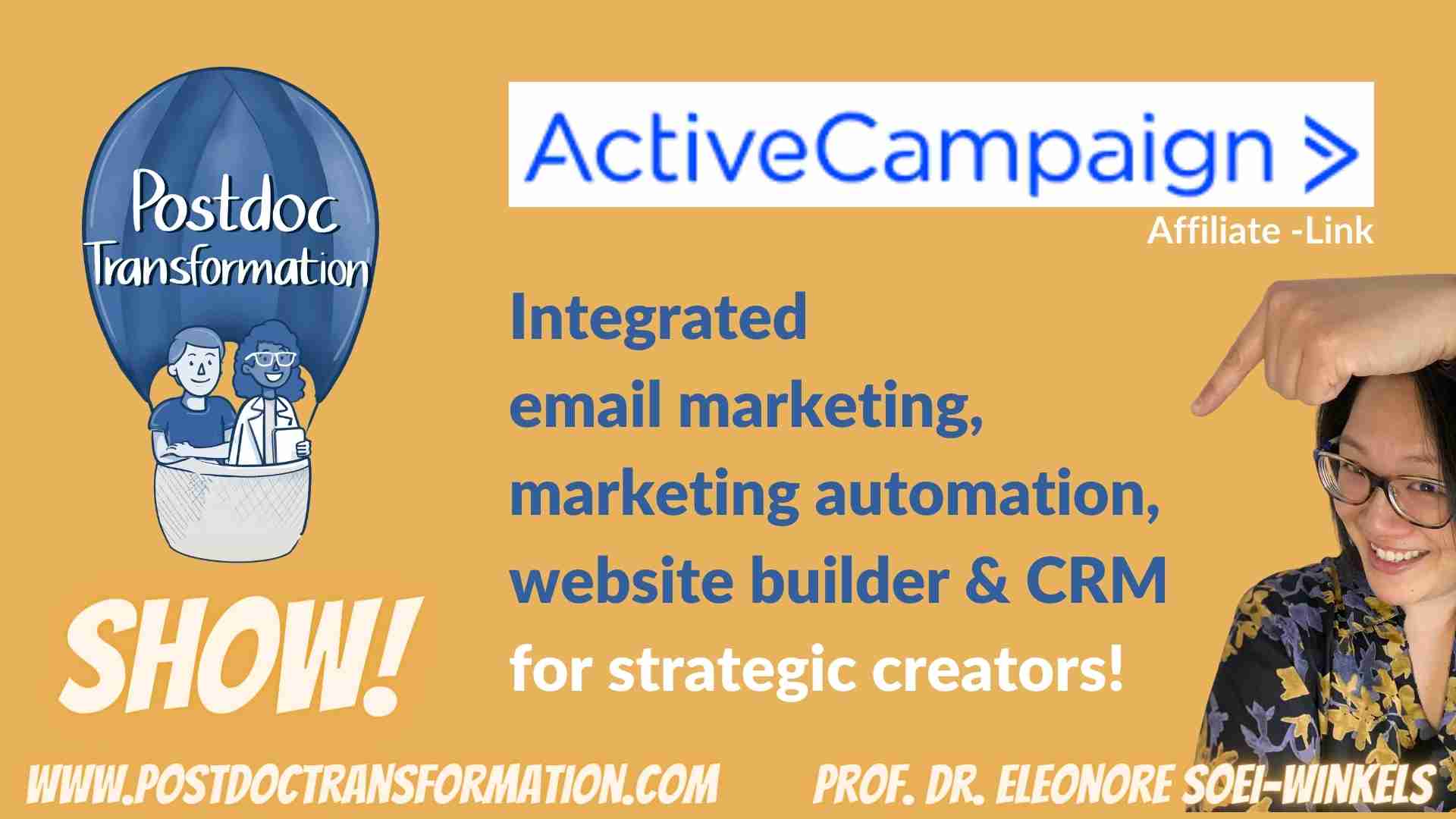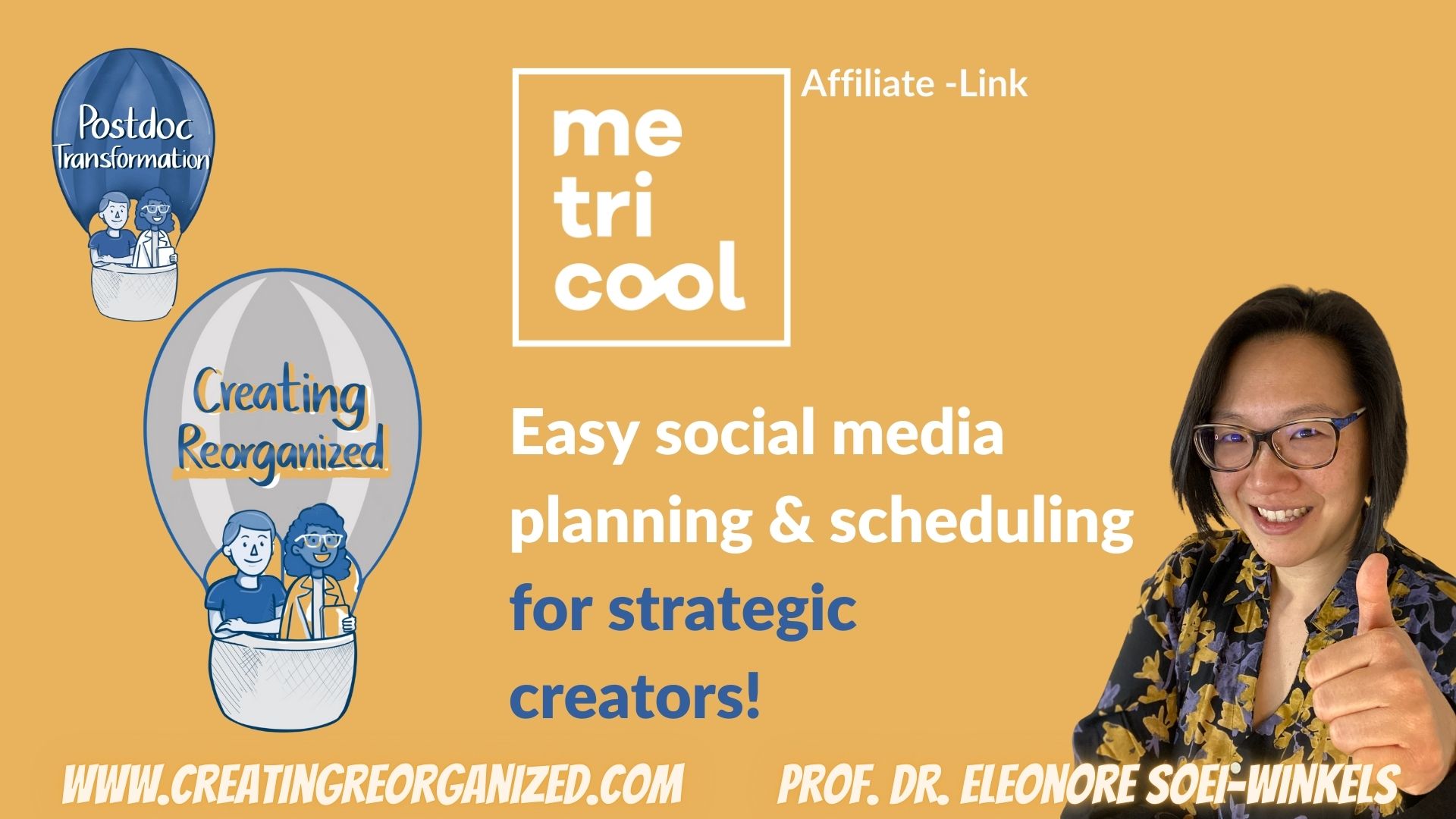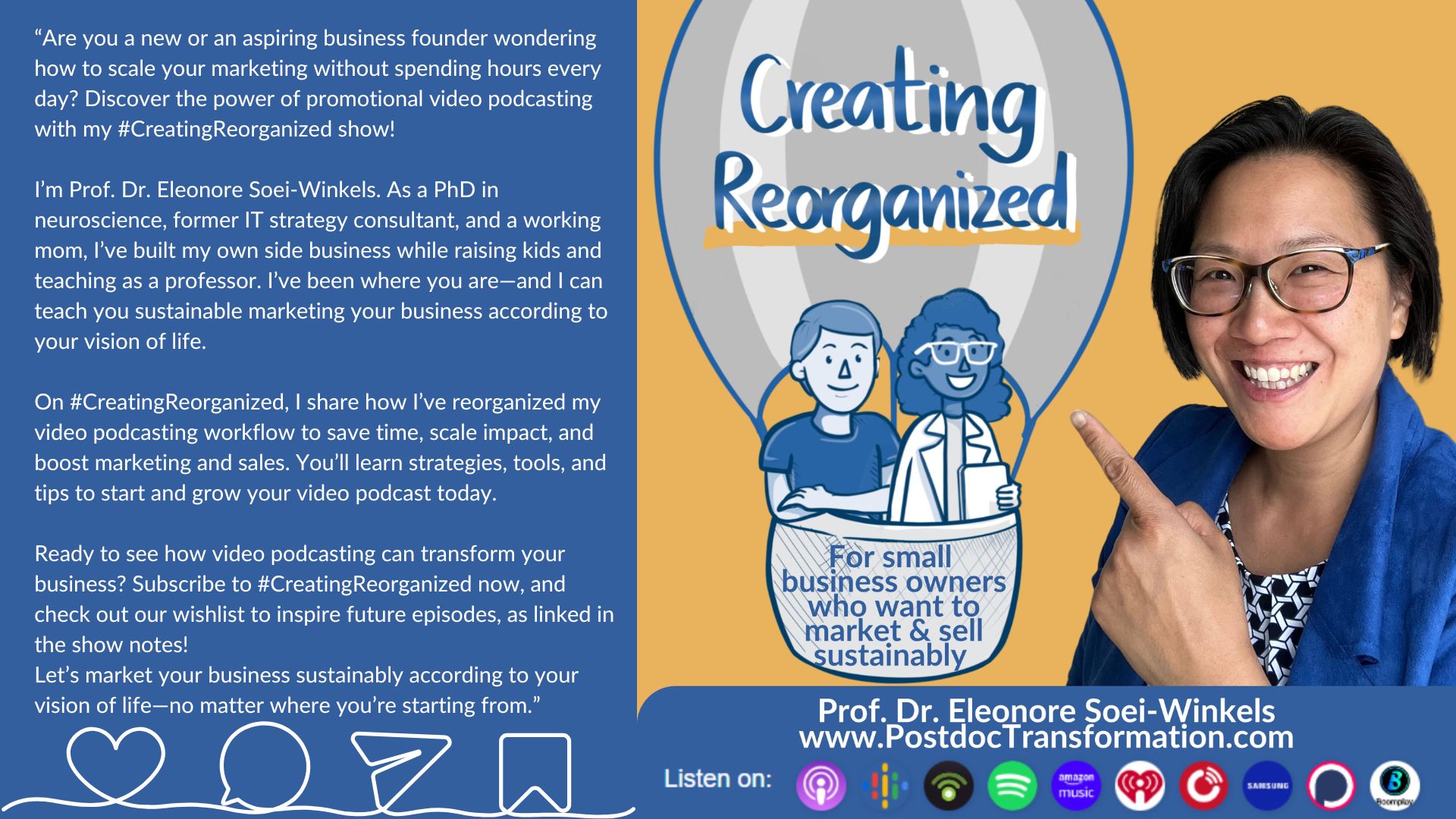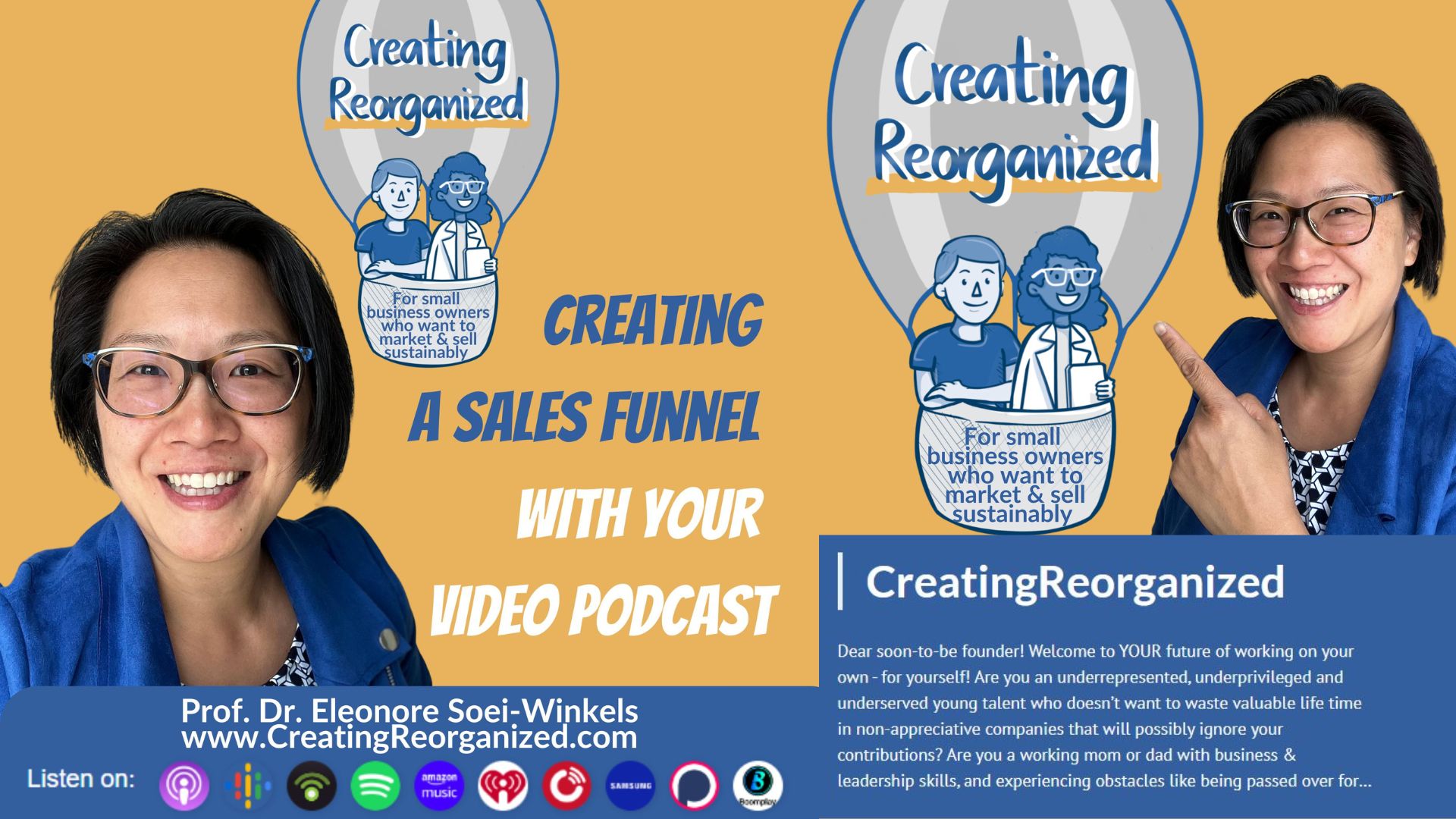
Creating a sales funnel with your video podcast, CreatingReorganized show
In this episode of the #CreatingReorganized show, Prof. Dr. Eleonore Soei-Winkels guides you as a small business owner, through the intricacies of creating a successful sales funnel using video podcasts. She begins by discussing the importance of having a sales funnel and how it can convert casual listeners into paying customers. Key concepts covered include understanding the stages of the sales funnel (awareness, interest, desire, and action) and how to map out a listener's journey. Prof. Soei-Winkels also highlights the importance of tools.
Additionally, she delves into the #ElaborationLikelihoodModel to explain how people process persuasive messages, helping you understand why a well-structured sales funnel is crucial for your business.
By the end of the episode, you’ll have actionable steps to set up your own video podcast sales funnel, learn strategies to nurture and convert leads, and know how to use psychological insights to enhance your #marketing efforts. Tune in for comprehensive guidance on transforming your #videopodcast into a dynamic sales machine.
If you are a new or aspiring founder of your small business and have no time to waste, or really struggle to do your social media marketing, you will enjoy our #CreatingReorganized show!
In my day job as a psychology professor I teach my bachelor and master students in real life, how to reorganize processes in a goal-directed and future-proof way in companies. That’s what I had done for a living as a former IT strategy consultant.
For my own career coaching business on the side, I can only dedicate a fraction of my time – because I prioritize care work for my little children. I face the same or similar challenges like all small business owners. So, I applied all my experience and knowledge to create my other video podcast #PostdocTransformation to streamline my social media marketing and to boost sales of my coaching, e-courses and affiliate products or services.
I strategically capitalize on professional tools to scale my impact according to my vision of life.
Listen and subscribe to this #CreatingReorganized show, so you will learn to do the same for your own business, to build the know, like and trust factor and to boost sales of your services or products!
Please also ask your business-specific questions, because for season 2, I envision interview episodes with aspiring and new founders like you, if you want to get your #CreatingReorganized according to your vision of life!
[00:02:15] Dear Creating Reorganizer, welcome to this episode of the CreatingReorganized Show, ehether you are a coach or a consultant, an e-commerce store owner, an educator, or even running a vacation business, like a ski hotel, or a gift shop with seasonal deals.
[00:02:26] Speaker: This episode will give you a clear roadmap to monetizing your video podcast.
[00:02:31] Speaker: We will also talk about powerful tools like ActiveCampaign for email optimization, Shopify for product sales, Thinkific for online courses, Typeform for lead magnets and metrical for scheduling your social media content.
[00:02:45] We will also talk about how you can video podcast to showcase your products or services in a brain friendly way using Descript and Podbean to cater neurodiverse needs of your leads. And I have been a power user for all of these tools, and later become an affiliate partner. I really love them and I shout them out without any hesitation. I'm not gatekeeping, so I really want you dear creative Reorganizer to win like me. If at any point you are thinking, I need a deep dive on it just drop the name of the tool, like Act of Campaign, Thinkific, Typeform Metrical Descript and Podbean. And I will plan a follow up episode. I am so, so, so, so honored to be celebrated. It was like a love shower for me in Podbean's New in-house podcast show called PodbeanAmplified, where I was selected to be the first in their inaugural season, episode one. Honestly, I did not see that coming, I'm really happy about that. Thank you Podbean.
[00:03:47] But now back to you dear, Creating Reorganizer. We will break it all down step by step as usual.
Sales Funnel
1) What it is and how it works for video podcasts
2) Mapping your listener's journey from casual audience member to paying customer
3) Common strategies and tool recommendations, practical examples and actionable steps to set up your own video, podcast, sales funnel.
4) A psychological model, theory or concept that underlines why you need a sales funnel for your business?
[00:04:21] And please stay tuned until the end of this episode because I have a gift for you. As you know, I'm a professor and I also have student consulting projects, I truly believe in the quality of my students' output. And hence, I will announce a gift at the end of this episode, so stay tuned.
[00:04:40] By the end of this episode, you will have the knowledge and tools to transform your video podcast into a dynamic sales machine that even works for you when you are on holiday, or just living your life.
[00:04:51] Part 1) What is a sales funnel and why does it matter?
[00:04:56] Let's start with the basics. What exactly is a sales funnel? A sales funnel is the journey your potential customers take. Starting from becoming aware of your brand to ultimately making a purchase. It's shaped like a funnel because not everyone who enters will make it to the end.
[00:05:19] So the AIDA model is a classic framework that aligns perfectly with video, podcast sales funnels.
[00:05:25] A like awareness, getting listeners to discovery of video podcasts,
[00:05:30] I like interest, capturing their curiosity and keeping them engaged.
[00:05:35] D like desire, building an emotional connection that makes them want what you are offering. So you need to know your target audience and
[00:05:45] A action converting them to paying customers.
[00:05:49] Okay, so they need to know why they want to have your solution. If they have no pain point, then it's not realistic to make money with them. Your video podcast is unique because you are naturally building a personal connection with your leads and clients, which makes a video podcast the perfect medium for nurturing listeners through each stage of this funnel.
[00:08:14] So to be clear, why it matters: without a sales funnel, your video podcast might entertain and inform, but it won't convert, and that can be a nice hobby. But obviously it eats up your time and financial resources. To be honest, you can use free software as a starter point, but to use that as a professional marketing arm for your business, you need to have professional tools, and that means you have to also invest in that.
[00:08:44] So you better make sure that it really converts at the end of the day for your business. A structured sales funnel ensures that every episode nudges listeners closer to a buying decision.
[00:08:54] Here's your actionable prompt. Sketch out a basic sales funnel for your video podcast, and identify one goal for each stage.
[00:09:02] For awareness. How will you attract new listeners interest? What will keep them coming back?
[00:09:08] Desire. How can you highlight the value of your product or service and action. Last but not least, what clear step will you encourage them to take?
[00:09:19] Just come back listening is not enough. They have to also buy from you something that you can use to finance the next episode, so to speak. And this marketing model is only the appetizers. Like I said, I will dovetail the elaboration likelihood model, which is a psychological model with a sales funnel steps at the end of this episode.
[00:09:49] Mapping the Listener's Journey
[00:10:00] Number one, top of the funnel. That's awareness.
[00:10:04] At this stage, your goal is to attract as many potential listeners as possible. Focus on topics that you know, address common pain points or interests. Aspirations within your niche. For example, if you're selling eco-friendly home products, create episodes like this. Five, surprising ways to reduce waste at home, the Hidden Costs of Fast Consumerism.
[00:10:28] These topics appeal to a broad audience, interested in sustainability.
[00:10:32] Number two, the middle of the funnel nurturing interests. Once business tune in, you can nurture their curiosity by sharing valuable insights, personal stories behind the scenes, and solutions that build trust and authority.
[00:10:47] Do not hold back. Okay? This is your first chance to be of value for them, so give them free value freely, right? That builds trust and authority. For example, in the eco-friendly products niche, you can discuss how I source sustainable materials from my products. The journey of building a green business from scratch. To be honest, when you're listening back to this, you can also think of this way you can already qualify your listeners by providing free value, ideally having the supply chain of you and the other companies in mind. That means your suppliers could be mentioned in your free value already, which makes them happy, which serves you well because at the end of the day, with this free value, your listeners get the impression that you know what you're talking about because you have the whole supply chain in mind.
[00:11:50] Speaker: And then we go to the bottom of the funnel. So we've been at the top, in the middle, and now at the bottom of the funnel.
[00:11:57] And that is where the conversion happens. This is where you have the major attention on, here's where you shift focus to turning engaged listeners into buyers. You can highlight your offerings and explain how they solve a problem or enhance their life.
[00:12:13] For example, behind the scenes, how we make our bestselling reusable kitchen towels. And if you want more about behind the scenes storytelling, I kindly remind you on the previous episode on storytelling from behind the scenes as linked in the show notes. Another example could be why investing in eco-friendly products saves you money over time.
[00:12:34] By mentioning money, it's also setting up the business perspective.
[00:12:39] Here's your actionable prompt: map one episode idea to each stage of the funnel. Write down a call to action for each episode, such as download our free sustainability checklist, or check out our limited product bundle.
[00:12:53] Something like that.
[00:12:54] And now part three.
[00:12:56] Creating Converting Content
[00:12:56] Converting content that converts. Okay, so now that we have mapped out the listener's journey, let's talk about how to create content that really drives conversions. So here's step one, attracting leads.
[00:13:09] Why of sales funnel starts with value? Before we can make any sales, we need leads. That is, people who are generally interested in what you offer and the best way is a lead magnet. A lead magnet is a free high value offer that your listeners can access in exchange for the email.
[00:13:29] Together with my students, I have prepared a lead magnet that you cannot resist. If you are one of the very first listeners of the Creating Reorganized Show we wanna give you something that we will disclose at the end of this episode, so stay tuned.
[00:13:44] a lead magnet works because it provides immediate value while also creating a relationship with your audience. Imagine this. Someone hears your video podcast, loves your content, and now they get something even more valuable for free that really builds trust.
[00:14:00] So for example, if you are a business coach, this could be a five step business growth map,
[00:14:07] or if you are an e-commerce store, you could say a 10% of coupon for first time buyers. Or if you are an educator, you can offer a free mini course like I do.
[00:14:19] If you are running a ski hotel, maybe a winter travel checklist could be a great freebie.
[00:14:23] Now you can think, does that work? People are bombarded with ads daily and they're hesitant to buy right away. So a lead magnet gives them something useful and builds a relationship before you even ask for a sale. And you can easily create these in TypeForm.
[00:14:40] Think interactive quizzes, downloadable guides or self-assessment. All of these I have already utilized for my PostdocTransformation show, and you will find a link to that in today's episode.
[00:14:54] And are you thinking, how can you direct your listeners to capitalize on your lead magnet? Well, that's easy. You can have a call to action. Head over to www website, blah, blah, blah, to grab your freebie as linked in the show notes,
[00:15:09] enter your email address in the form as linked in the show notes.
[00:15:12] If you now want to deep dive on lead magnets, for example, how I use TypeForm to create these kinds of lead magnets,
[00:15:19] just type in "Typeform" in the comments and I'll know what to do.
[00:17:31] Nurturing and Converting Leads
I love automation. I have been an IT strategy consultant. I don't wanna do manually everything. I gladly test. Manually, but as soon as I have enough data to see that this is worth automizing, I will do that.
[00:17:51] Of course. So now that people have signed up, you don't wanna just send them a single email and disappear. And this is where ActiveCampaign enters the stage.
[00:18:00] For starters, what is email nurturing? Think of it like, dating no one proposes on the first date.
[00:18:07] Right? That really is awkward, so you need to warm up the relationship over time. And email nurturing is key because most people don't buy immediately. They need to know, like, and trust you first. And that's why we send follow up emails to keep them engaged. ActiveCampaign has templates you can use and customize for your business. You need to have a welcome email. Thanks for signing up. Here's your freebie. You can have value driven emails, share helpful tips, a podcast episode or a personal story.
[00:18:39] Introduce your products and services gradually. I personally love segmentation. If someone clicks a link about A or B or whatever, then automatically that person gets a tag as interested in A, B, or C or whatever. So I can follow up later as I like.
[00:18:57] I can segment a group that gets only emails regarding A versus another group that gets emails for B.
[00:19:03] Speaker: Here's a real live example.
[00:19:06] I have a free email course with 10 emails that are really value packed, and whoever goes through the whole sequence usually picks up the email.
[00:19:19] Speaker: And sends that to the graduate school. So I can then start a conversation of how to get into the program so that I can offer my e-courses or even in-person workshops. So that 10 email sequence is really important to the listener to get to know me, to trust enough that I would make a good career transition coach at their university.
[00:19:44] So again, why it works, an email sequence helps build relationships and guides potential customers through the decision making process without overwhelming them. If you want a full tutorial on ActiveCampaign automations, let me know. I will gladly do that for you.
[00:20:01] All right, step number three, now you want to convert leads into customers. Your subscribers are now engaged. Great. Now it's time to make an offer. So for starters, why now at this stage. Your audiences build trust with you, making them far more likely to say, yes, they are warmed up.
[00:20:21] If you sell products on Shopify, you can now automate abandoned cards, recovery emails. If you, for example, if you are selling products on Shopify, they wanna check out, but then get distracted or something like that. But you can set up and automate abandoned card recovery emails to bring back lost sales.
[00:20:43] Or if you are running an e-course on Thinkific, you can send early bird discounts or invite them to a live q and a webinar. So this way you can tie your connection with them even closer. If you have a seasonal gift drop, you can offer a holiday gift guide to highlight your best products.
[00:21:01] And again, why does it work, making an offer at the right time when they're ready to buy because they have grown to know you to like you, to trust you with the right incentive helps reduce hesitation and boost conversions.
[00:21:15] So step number four, that is upselling, cross-selling and customer retention.
[00:21:20] So upselling means offering a premium package or a VIP version of your product. For example, if someone buys a basic online course, you can offer them a one-on-one coaching upgrade provided that you have time of course. Or for cross selling, you can suggest complimentary products.
[00:21:37] For example, a customer who buys ski gloves, offer them a matching winter scarf from. Your other suppliers that makes the other suppliers also happy, right? You are thinking from a supply chain perspective that is always serving you in the long run.
Retention
[00:23:30] Speaker: About retention well, you need to keep customers engaged with viable content, follow-ups and personal offers.
[00:23:37] Why? Well, it's easier to make a happy customer even more happy. They already fit to you, they are already your ideal customer, right? They have already bought what you are offering and serving and producing. So keep them engaged.
[00:23:54] You can also offer them something new later down the road on your value ladder.
[00:23:59] Essentially, this is also what I'm doing with my ideal client avatar from the PostdocTransformation Show. Some of them will come to the point in their life that they think they can also found their own business. They can also start up their own company, and that's when my CreatingReorganized show will be helpful.
[00:24:22] Until then, I'm nurturing. Of course I'm nurturing. None of the scientists who are currently doing their PhD thinking of how to get employed in business are thinking of starting their own companies. That's a little farfetched, but I am nurturing them in the PostdocTransformation Show and some of them will also find value and my CreatingReorganized show that can be a different target group altogether, but I'm already nurturing them ideally from the PostdocTransformation show.
[00:24:55] Now here's my favorite part.
[00:24:57] Psychological Insights and Sales Funnels
[00:24:57] Number four, dovetailing a psychological model theory or concept for you and tadah, I chose the elaboration likelihood model to explain why you need a sales funnel for your business. That explains how people process persuasive messages and make decisions.
[00:25:16] It was developed by Richard Petty and John Cacciopo in the late 1980s.
[00:25:20] The model suggests that there are two main ways. People process information when they encounter persuasive messages.
[00:25:28] Number one, the central route.
[00:25:30] The central route involves deep and thoughtful processing of the message. When people are motivated and have the ability to focus on the details, they carefully evaluate information presented. This route requires the audience to think critically about the arguments, evidence and reasoning behind the message and the decision making process in this route is more deliberate and informed, I think that you can see from my gesture and also from my facial expression that. It is a little bit farfetched,
[00:26:06] But to make this possible, here are some key factors you have to consider. You need to have a highly motivated audience, the person. Who wants to buy needs to care about the topic or the decision they're making. They also have to have the highest ability possible.
[00:26:25] The person has to have cognitive resources to understand, and the mental focus to analyze the message deeply. Ideally people persuaded via the central route make decisions that are more enduring and resistant to change, and they have actively processed and evaluated the content as they have actively processed and also evaluated the content.
[00:26:50] Like I say, that's ideal, but to be honest. You probably have already felt through how I talked about it, that I think that is very unlikely. Okay, it's more probable that your listeners will go the peripheral route. Okay. So what is the peripheral route? Well, it's in the periphery, so not central. It involves superficial processing of the message. Okay? So people here are more influenced by external cues, such as the attractiveness of the speaker, their trustworthiness, the emotional appeal rather than the strength or quality of the arguments themselves.
[00:27:33] And this route occurs when the person is less motivated or lacks the ability to engage with the content in a deep way. Okay, interested, but only superficially.
[00:27:46] So here are the key factors to consider in your video podcast. People are lowly motivated, not highly invested in the message or the decision at hand, not the key decision maker. Maybe not yet there. Doesn't know why. Too early, too late, and maybe has a low ability.
[00:28:07] So the listener could be distracted, overwhelmed, or simply uninterested in analyzing the message deeply, when I'm thinking about myself, how I process video podcasts, then obviously also I do other things at the same time.
[00:28:22] I listen to a video podcast while I am driving my car, while I'm waiting for my kids. And obviously when something else happens, I stop right away because it's not my top priority.
[00:28:34] I'm not listening to a video podcast because I'm studying. Even though I have set up my video podcast, both the PostdocTransformation show and also the CreatingReorganized show in the sense that you can have actionable prompts and then you can jot down your notes.
[00:28:49] I'm fully aware that this is not happening in most of the cases because you are human, because you haven't paid for this video podcast, so you are not invested. You are, taking your time. But time is also easily preoccupied by other things. So as soon as people have paid for, then obviously the engagement is higher.
[00:29:16] And that means it's the central route. But for a video podcast, we're talking about the peripheral route here. So the outcome is people persuaded via the peripheral road tend to make more temporary, less stable decisions, which can be easily influenced by subsequent persuasive messages. And this is where the beauty is for you as a business owner. The sales funnel is a process that leads potential customers through stages, form awareness to consideration, and ultimately to purchase.
How the elaboration likelihood model maps to the four steps of a sales funnel
[00:31:02] So the two routes, the central and the peripheral route of the elaboration likelihood model play an important role in shaping how potential customers engage with your funnel in different stages. Here's how the elaboration likelihood model maps to the four steps of a sales funnel.
[00:31:20] Step number one, awareness top of the funnel. So which one now is the route engaged? It's the. Peripheral route. In this early stage, potential customers are just becoming aware of your product or service. They might not yet be highly invested or motivated to dive deeply into the details.
[00:31:41] Instead, they're more likely to browse, doom scroll on social media, and then they think, oh, this is interesting, maybe click on it or not. Maybe I listen to that or not on my podcast player. So there are more likely to be influenced by external cues such as a catchy headline, attractive visuals, a strong emotional appear.
[00:32:02] So fear of missing out, urgency, you have to include that also in your communication.
[00:32:08] Lead magnets, free content or social media ads are a good example for how the peripheral route works here. The goal is to capture attention and spark interest through simple, emotionally engaging content that encourages people to move to their next step.
[00:32:24] And think of eye-catching visuals. Influencer endorsements are limited time offers that make people want to learn more. I don't have the illusion that when I share my social media clips on social media that I can share content like this. I'm not explaining a psychological concept model or theory on social media.
[00:32:47] But if you have paid closer attention to what I have put out for social media clips, it's always the more superficial content that is catching the attention but is not going in depth. If people want to know more, then I can serve them that deep knowledge in the video podcast.
[00:33:06] And still, I know that they're not sitting there and jotting their notes. I hope so, but they're not.
[00:33:15] All right. So,
[00:33:16] step two, it's the interest and that's the middle of the funnel. Guess now which one is the route engaged again? It's still the peripheral route, but with some movement toward the central route. Here's the explanation why. In the middle of the funnel, people are beginning to express interest in what you're offering and they may start to consider how it fits.
[00:33:41] Their needs, their pain points. Here they still may be influenced by external cues such as reviews, social proof, but they also begin engaging more seriously with your content. At this stage, people are likely to weigh in the, perceived trustworthiness of your brand and consider how your product may impact their lives for the better.
Sign up to our CreatingReorganized inner circle newsletter, where you can learn and apply my tactical tricks to your marketing challenges and see how business podcasting can help you strategically to reach your goals
Sign up now via this form (made in ActiveCampaign):
[00:34:05] So here's your goal. You need to deepen their interests by providing testimonial videos, case studies, or webinars that both appeal to their emotions through social proof and begin engaging their logic. When they think of your product, this is where emotion and trust come into play alongside more substantial information consideration.
[00:34:28] That's the bottom of the funnel. And guess what the route engage is now? Yes. It can only be the central route. The explanation of why now potential customers are seriously considering your product or service. Okay. So there are motivated to weigh the pros and cons, to evaluate pricing and decide if it will truly meet their needs.
[00:34:52] At this point, they're engaging in critical thinking. They are about to put money on the table, so they really want to know whether their return on invest is valuable for them or not. So your content needs to be more detailed and logically sound. It needs to provide in-depth arguments about the value and benefits of your product.
[00:35:12] What they will end up with, if they are not buying with you.
[00:35:16] Comparison charts or frequently asked questions are example of how to engage the central route.
[00:35:21] So the goal is to move the audience toward a purchase decision by providing high quality, thoughtful content, in-depth explanations, data backed claims that addresses objections, builds trust, and clarifies any doubts.
[00:35:38] You must be the go-to person they wanna buy from.
[00:37:04] Speaker: And then step four conversion, and that is the action. And of course, here we have, again, two routes. The routing gauge is the central route, but it's also influenced by powerful cues for urgency. Okay, so here's the explanation why that works.
[00:37:23] This is where the decision is made and the person is ready to act. You engage the central route by offering the finer persuasive arguments and incentives for example, the product bundle or the discounts. The powerful route can also play a role in creating urgencies, such as a limited time offer. Scarcity, only five left.
[00:37:45] These tactics tap into emotional triggers and can push the decision over the line. Your goal is to push the potential customer to take action. You want them to complete the purchase to sign up. You can ask them to do that with a clear, compelling call to action while creating an emotional urgency because you have a countdown timer or a last chance discount that disappears.
[00:38:14] In summary, the elaboration likelihood model explains how persuasion works through either the central route that is deep, thoughtful processing, or the peripheral route, which is superficial cues, and your sales funnel video podcasts should use both routes at different stages. In the early stages, you focus more on the peripheral cues to capture attention. While the later stages engage the central route to foster deeper evaluation and motivate purchase decisions.
[00:38:46] By understanding this model, you can craft content that resonates with your potential customers at each stage of the sales funnel, leading them to take action.
[00:38:57] Speaker: Before we now unveil our new gift. I wanna wrap up and here's what we have covered. So number one, we now understand what a sales funnel is and how it works for a video podcast. Number two, you can now map your listener's journey from casual audience to paying customer. And then number three, you now have content strategies and tool recommendations, practical examples and actionable steps to set up your own video podcast sales funnel. Now you know that the elaboration likelihood model underlines why you need a sales funnel for your business.
[00:39:30] So your challenge for this week is to map out your video podcast sales funnel, and you can create one piece of funnel aligned content and track its performance.
Your free gift as a small business owner, created and delivered by my students in real life!
[00:40:41] All right, now it's time for your gift Dear. CreatingReorganizer. So it's called Start Your Video Podcast with CreatingReorganized. As you all know, in real life I'm a professor for industrial and occupational psychology and in my lectures I offer a student consulting project for my Bachelor students.
[00:41:00] They must consult a real small business? Well, in the past we really had trouble to find suitable projects, this is where you enter the stage.
[00:41:12] Okay, so. I wanna help real small business owners like you as you are listening to the CreatingReorganized Show to start a business promotional video podcast. And they, my students want to consult. So maybe this is a win-win for all of us as a project outcome. You as a small business owner would get a customized list of 10 episodes according to my CreatingReorganized strategy plus.
[00:41:39] Two to four ready to be recorded video podcast scripts, depending on the group size of the students. So this gift is free for you dear CreatingReorganizer as you help My Young Bachelor students who don't really have a lot of practical experience, but they want to get their feet wet In the world of corporate consulting, and this is where I come into place because I have been an IT strategy consultant for Accenture, so I can guide them, but we need content and that's where you enter the stage.
[00:42:11] So I thank you for helping my young students. We will give you a free customized list of 10 episode titles and a handful of ready to record scripts to start your own video podcast to promote your small business. To sign up, check out the link, start your video podcast in our show notes, this is the first time that we offer this.
[00:42:32] To make this even more appealing to the German small business owners, we are offering this also in German. Thank you for joining us on our CreatingReorganized show.
[00:42:43] Don't forget to subscribe. Leave a review and share this episode with your small business owner bestie, who wants to turn their video podcast into a revenue generator.
[00:42:53] This is the final episode of our season one of the CreatingReorganized Show. I hope that you have found a lot of value so that you can create your own video podcast. And now we have a season break because in April, we'll start season six of our PostdocTransformation Show with eight episodes. And then once we have ended this, I will start with a second season of the Creative Reorganized Show. So stay tuned and watch us on the PostdocTransformation Show where we will do all the things CreatingReorganized!
To celebrate this season of the Creating Reorganized show, I want to offer you a business podcasting internship for four weeks. You can apply or join the wait list for the next season for this treat by sharing why you want to do a business promotional podcast. What your services or products are. And [00:53:00] if you and your business are in line with my own values, I will strategize, conduct, and produce with you your first three episodes.
For the first one, I take the lead and you shadow me. For the second one, you do the work and I help you out. For the third one, you are on your own with me, cheering for you on the sidelines. For more details, click on the image below to send me an email and we will send you the application details.
Do you want to start your own site business as a runway for your better future? Then you will benefit from our free business readiness quiz as linked in the show notes. Are you a small business owner and want to create sustainable marketing and sales content? Try video podcasting about your service or product like I do in my postdoc transformation show.
I'm a mom of two kids in school and a professor and I have no time to lose running my business. And if you also want to save time and energy, use our dovetailed [00:54:00] evergreen strategy. You can easily derive countless valuable social media content from just one video podcast episode. You can quickly attract a broad audience across many social media platforms and then nurture them into leads and clients in their ears and emails while you live according to your vision of life.
Let me teach you CreatingReorganized. If you're ready to dive in and start your own podcasting journey, I highly recommend checking out the tools I mentioned earlier: podbean, Descript, Typeform, ActiveCampaign, Thinkific, and Metricool. Each of these services has made my podcasting business experience smoother and more efficient, and I trust that they can help you too.
Thank you for listening to our CreatingReorganized show. If you found this episode helpful please subscribe, share it with your business friends and leave a review on your favorite podcast player. Your feedback helps me as a small business owner to serve more small business owners for free. So thank you.
I'm your host, Professor [00:55:00] Dr. Eleonore Soei-Winkels.
And now I wish you a happy CreatingReorganized according to your vision of life.
